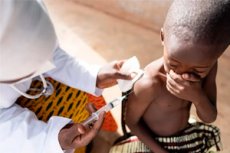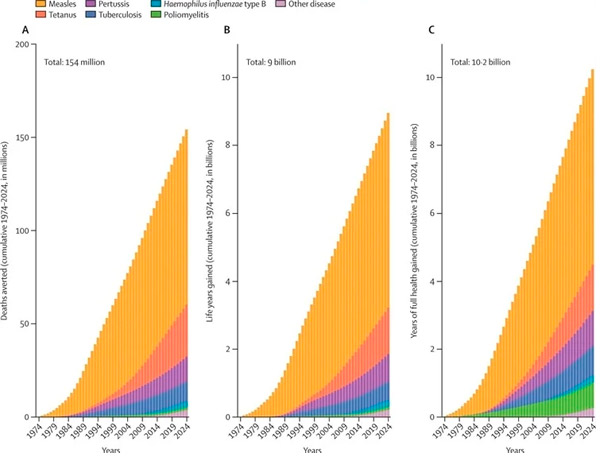New publications
50 Years of Saving Lives through Vaccination: WHO EPI Program Saves 154 Million Lives
Last reviewed: 02.07.2025

All iLive content is medically reviewed or fact checked to ensure as much factual accuracy as possible.
We have strict sourcing guidelines and only link to reputable media sites, academic research institutions and, whenever possible, medically peer reviewed studies. Note that the numbers in parentheses ([1], [2], etc.) are clickable links to these studies.
If you feel that any of our content is inaccurate, out-of-date, or otherwise questionable, please select it and press Ctrl + Enter.

In a recent study published in The Lancet, researchers examined the public health impact of the World Health Organization’s Expansion of Immunization (EPI) program. The World Health Assembly established EPI in 1974, a significant step toward expanding the benefits of vaccination to everyone. WHO launched the initiative with the initial goal of vaccinating children against measles, polio, smallpox, whooping cough, tetanus, diphtheria, and tuberculosis by 1990. EPI now includes protection against other pathogens for all age groups. Expanding vaccination programs to more diseases has led to significant increases in protection.
In this study, the researchers modelled the public health impact of EPI. They estimated the number of deaths averted, disability-adjusted life years gained (i.e., disability-adjusted life years), and life years gained due to vaccination against 14 pathogens from June 1974 to May 2024 in WHO Member States.
Vaccination against the following pathogens/diseases has been introduced: tuberculosis, yellow fever, Haemophilus influenzae type B, diphtheria, Japanese encephalitis, whooping cough, measles, rotavirus, polio, rubella, invasive pneumococcal disease, tetanus, meningitis A, and hepatitis B. A standardized system for assessing the impact on a fully vaccinated individual has been developed.
The team synthesized vaccination coverage estimates from the WHO Polio Information System, Supplemental Immunization Activities Database, Immunization Dashboard, and the Vaccine Impact Modelling Consortium (VIMC). A total of 24 vaccination events were estimated, categorized by disease, vaccine, dose number, and routine or supplementary immunization. The modeling took three forms. Initially, impact estimates were obtained by simulating published transmission models for polio and measles over a 50-year period. Second, the VIMC transmission models were extended to include hepatitis B, rotavirus, rubella, H. influenzae type B, invasive pneumococcal disease, and Japanese encephalitis from 2000 to 2024. Third, static disease burden models for tuberculosis, pertussis, tetanus, and diphtheria were refined. The three forms of modeling allowed for individual- and population-level effects of vaccination. The primary outcome was to estimate the impact of the EPI on deaths averted, life years gained, years of good life, and the proportion of the reduction in infant mortality attributable to vaccination. In addition, as secondary outcomes, these interventions were estimated by World Bank income strata and by region.
The researchers estimated that vaccination programs against 14 pathogens prevented about 154 million deaths from June 1974 to May 2024; this included 146 million prevented deaths among children under five. In addition, 10.2 billion years of useful life and nine billion years of life were gained during this period. On average, 66 years of useful life and 58 years of life were gained.

Deaths averted, life years saved, and full-life years gained due to vaccination (cumulative data 1974–2024). Measles: Deaths averted: 93.7 million; Life years saved: 5.7 billion; Full-life years gained: 5.8 billion. Tetanus: Deaths averted: 27.9 million; Life years saved: 1.4 billion; Full-life years gained: 1.4 billion. Pertussis: Deaths averted: 13.2 million; Life years saved: 0.8 billion; Full-life years gained: 1 billion. Tuberculosis: Deaths averted: 10.9 million; Life years saved: 0.6 billion; Full-life years gained: 0.9 billion. Haemophilus influenzae type B: Deaths averted: 2.8 million; Life years saved: 0.2 billion; Good life years gained: 0.2 billion. Polio: Deaths averted: 1.6 million; Life years saved: 0.1 billion; Good life years gained: 0.8 billion. Other diseases: Deaths averted: 3.8 million; Life years saved: 0.2 billion; Good life years gained: 0.3 billion. Notably, 0.8 billion good life years were gained by preventing cases of polio. Measles vaccination has saved 93.7 million lives over 50 years and was the single most significant life-saving factor across all WHO regions and World Bank income strata. In addition, there has been a significant decline in global infant mortality since 1974, with vaccination directly accounting for 40% of this achievement.
People aged 10, 25 or 50 years in 2024 were estimated to be 44%, 35% or 16% more likely, respectively, to survive the following year compared to a hypothetical scenario of no vaccination since 1974. The African and Eastern Mediterranean regions showed the largest absolute gains in lifetime survival probability, while the European region had the smallest. On the other hand, the European and Western Pacific regions had the largest relative gains, while the African region had the smallest.
The results show that vaccines have saved an estimated 154 million lives since 1974, the majority (95%) of which were in children under five years of age. This translates into nine billion life years saved and 10.2 billion healthy life years gained through vaccination. Notably, measles vaccination was the most significant contributor. In addition, vaccination is responsible for almost half of the global decline in infant mortality. Consequently, a child born in 2024 will have a 40% increased probability of survival each year. Furthermore, the survival benefits of infant vaccination extend beyond age 50. Regions with high initial mortality had large absolute gains but lower relative gains.
